TAXATION Assignment: Capital Gains, FBT, and Income Tax Law
VerifiedAdded on 2020/04/01
|8
|1604
|40
Homework Assignment
AI Summary
This taxation assignment addresses several key areas of tax law, including capital gains and losses under ITAA 1997, the calculation of Fringe Benefits Tax (FBT) based on statutory and actual interest rates, and the allocation of losses from rental properties owned jointly. It analyzes the implications of tax rulings such as TR 93/6 and TR 93/32, and the case of F.C of T.v. Mc Donald (1987). The assignment also discusses tax avoidance principles derived from the case of IRC v Duke of Westminster [1936] AC 1, and evaluates income assessment from the sale of felled timber under the Income Tax Assessment Act 1936, referencing relevant taxation rulings. The assignment aims to provide a comprehensive understanding of taxation principles and their application in various scenarios.
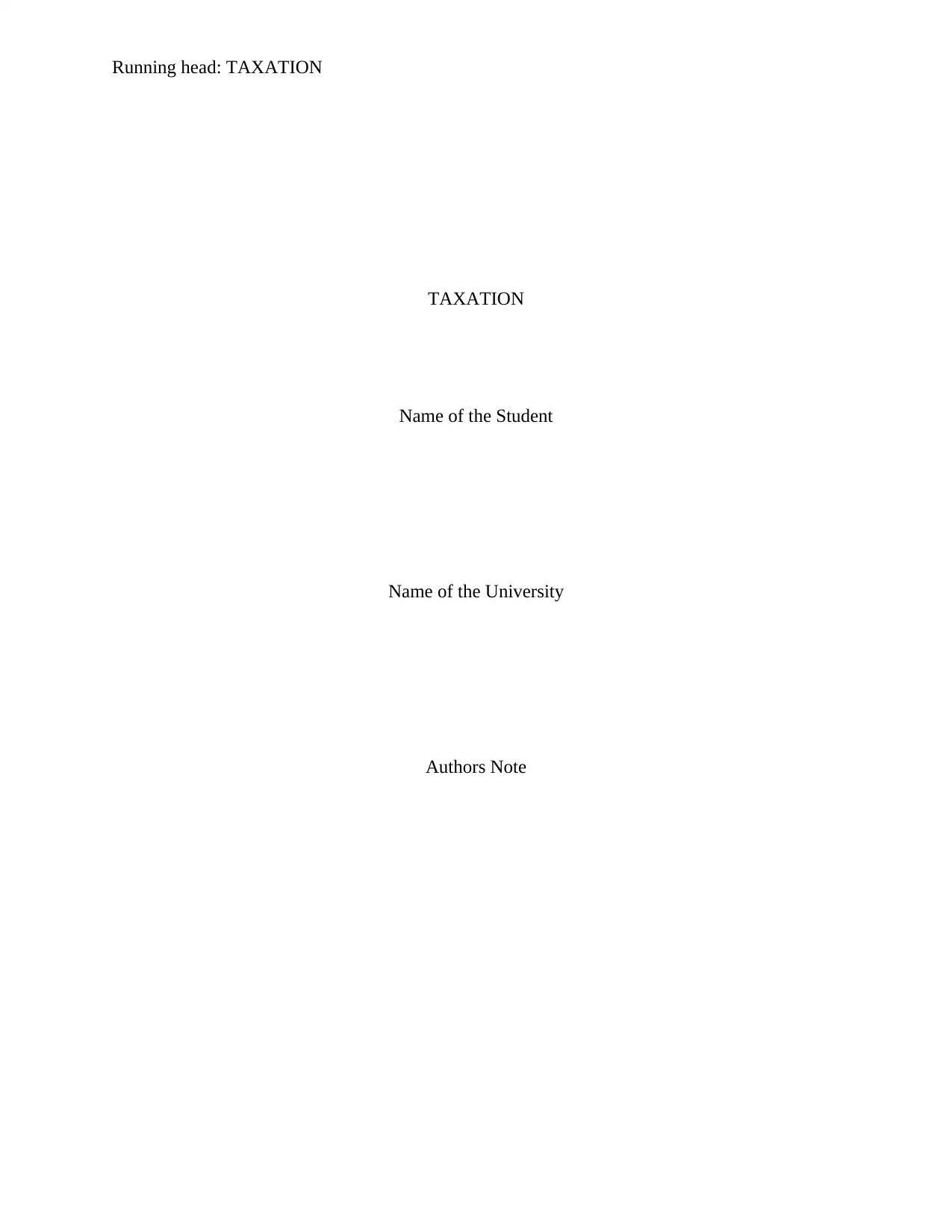
Running head: TAXATION
TAXATION
Name of the Student
Name of the University
Authors Note
TAXATION
Name of the Student
Name of the University
Authors Note
Paraphrase This Document
Need a fresh take? Get an instant paraphrase of this document with our AI Paraphraser
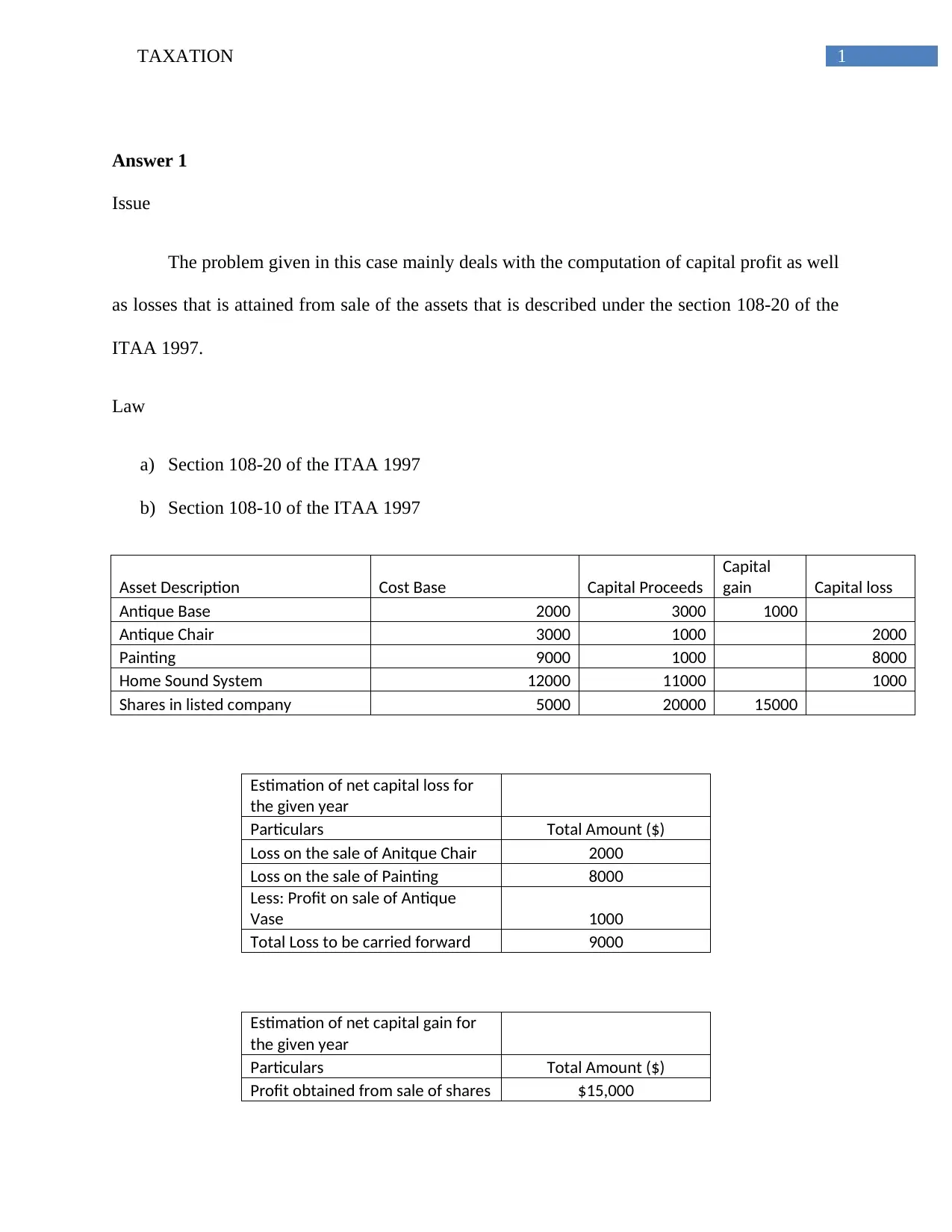
1TAXATION
Answer 1
Issue
The problem given in this case mainly deals with the computation of capital profit as well
as losses that is attained from sale of the assets that is described under the section 108-20 of the
ITAA 1997.
Law
a) Section 108-20 of the ITAA 1997
b) Section 108-10 of the ITAA 1997
Asset Description Cost Base Capital Proceeds
Capital
gain Capital loss
Antique Base 2000 3000 1000
Antique Chair 3000 1000 2000
Painting 9000 1000 8000
Home Sound System 12000 11000 1000
Shares in listed company 5000 20000 15000
Estimation of net capital loss for
the given year
Particulars Total Amount ($)
Loss on the sale of Anitque Chair 2000
Loss on the sale of Painting 8000
Less: Profit on sale of Antique
Vase 1000
Total Loss to be carried forward 9000
Estimation of net capital gain for
the given year
Particulars Total Amount ($)
Profit obtained from sale of shares $15,000
Answer 1
Issue
The problem given in this case mainly deals with the computation of capital profit as well
as losses that is attained from sale of the assets that is described under the section 108-20 of the
ITAA 1997.
Law
a) Section 108-20 of the ITAA 1997
b) Section 108-10 of the ITAA 1997
Asset Description Cost Base Capital Proceeds
Capital
gain Capital loss
Antique Base 2000 3000 1000
Antique Chair 3000 1000 2000
Painting 9000 1000 8000
Home Sound System 12000 11000 1000
Shares in listed company 5000 20000 15000
Estimation of net capital loss for
the given year
Particulars Total Amount ($)
Loss on the sale of Anitque Chair 2000
Loss on the sale of Painting 8000
Less: Profit on sale of Antique
Vase 1000
Total Loss to be carried forward 9000
Estimation of net capital gain for
the given year
Particulars Total Amount ($)
Profit obtained from sale of shares $15,000
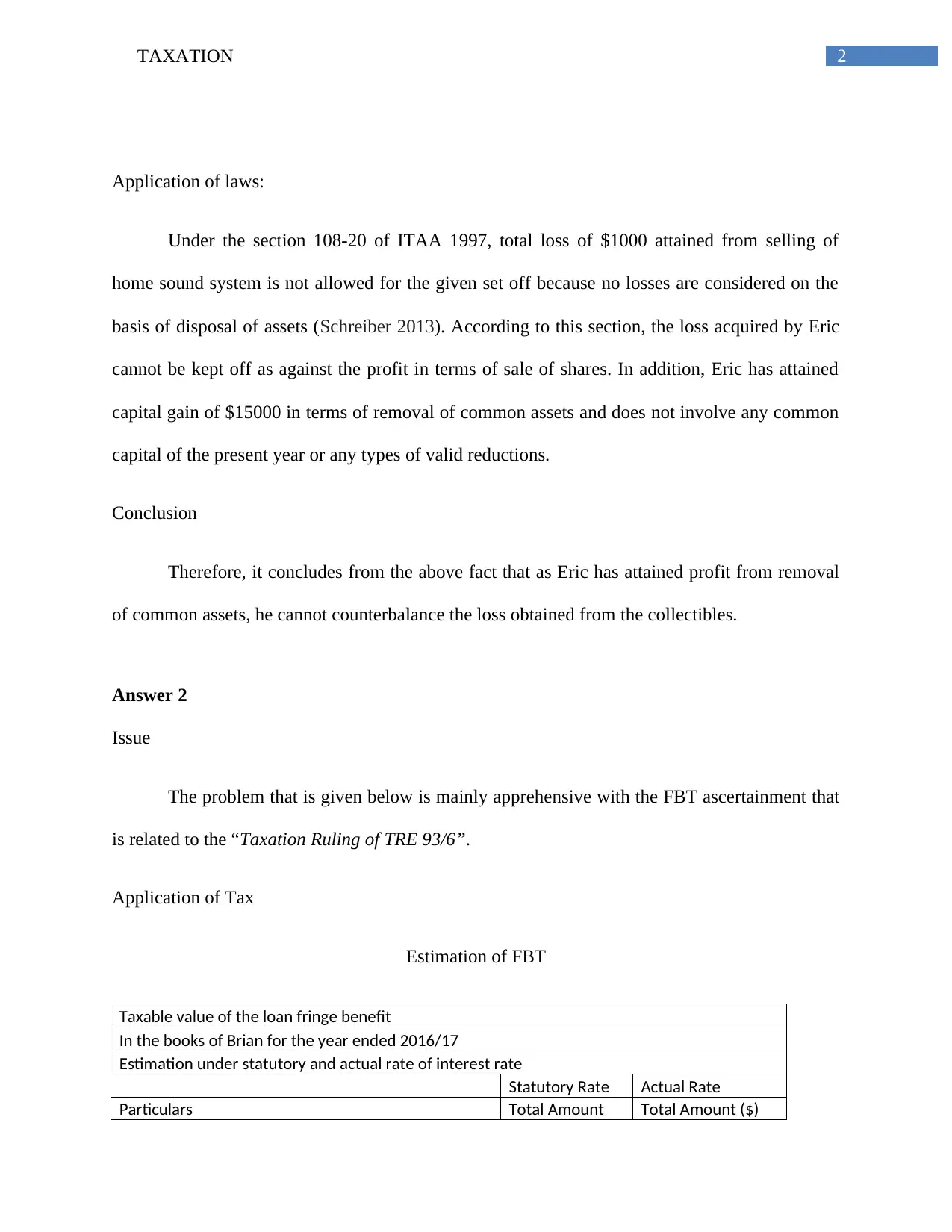
2TAXATION
Application of laws:
Under the section 108-20 of ITAA 1997, total loss of $1000 attained from selling of
home sound system is not allowed for the given set off because no losses are considered on the
basis of disposal of assets (Schreiber 2013). According to this section, the loss acquired by Eric
cannot be kept off as against the profit in terms of sale of shares. In addition, Eric has attained
capital gain of $15000 in terms of removal of common assets and does not involve any common
capital of the present year or any types of valid reductions.
Conclusion
Therefore, it concludes from the above fact that as Eric has attained profit from removal
of common assets, he cannot counterbalance the loss obtained from the collectibles.
Answer 2
Issue
The problem that is given below is mainly apprehensive with the FBT ascertainment that
is related to the “Taxation Ruling of TRE 93/6”.
Application of Tax
Estimation of FBT
Taxable value of the loan fringe benefit
In the books of Brian for the year ended 2016/17
Estimation under statutory and actual rate of interest rate
Statutory Rate Actual Rate
Particulars Total Amount Total Amount ($)
Application of laws:
Under the section 108-20 of ITAA 1997, total loss of $1000 attained from selling of
home sound system is not allowed for the given set off because no losses are considered on the
basis of disposal of assets (Schreiber 2013). According to this section, the loss acquired by Eric
cannot be kept off as against the profit in terms of sale of shares. In addition, Eric has attained
capital gain of $15000 in terms of removal of common assets and does not involve any common
capital of the present year or any types of valid reductions.
Conclusion
Therefore, it concludes from the above fact that as Eric has attained profit from removal
of common assets, he cannot counterbalance the loss obtained from the collectibles.
Answer 2
Issue
The problem that is given below is mainly apprehensive with the FBT ascertainment that
is related to the “Taxation Ruling of TRE 93/6”.
Application of Tax
Estimation of FBT
Taxable value of the loan fringe benefit
In the books of Brian for the year ended 2016/17
Estimation under statutory and actual rate of interest rate
Statutory Rate Actual Rate
Particulars Total Amount Total Amount ($)
⊘ This is a preview!⊘
Do you want full access?
Subscribe today to unlock all pages.

Trusted by 1+ million students worldwide
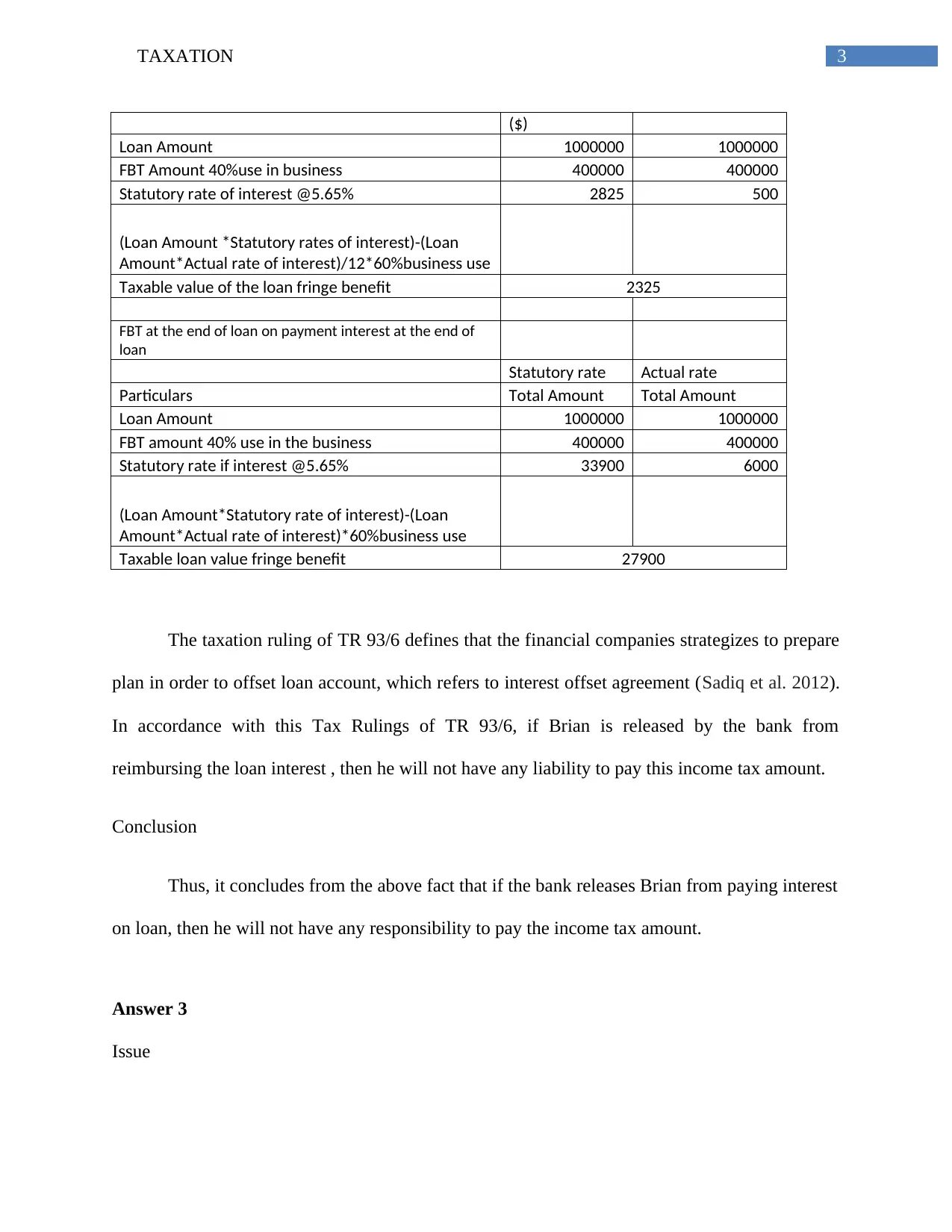
3TAXATION
($)
Loan Amount 1000000 1000000
FBT Amount 40%use in business 400000 400000
Statutory rate of interest @5.65% 2825 500
(Loan Amount *Statutory rates of interest)-(Loan
Amount*Actual rate of interest)/12*60%business use
Taxable value of the loan fringe benefit 2325
FBT at the end of loan on payment interest at the end of
loan
Statutory rate Actual rate
Particulars Total Amount Total Amount
Loan Amount 1000000 1000000
FBT amount 40% use in the business 400000 400000
Statutory rate if interest @5.65% 33900 6000
(Loan Amount*Statutory rate of interest)-(Loan
Amount*Actual rate of interest)*60%business use
Taxable loan value fringe benefit 27900
The taxation ruling of TR 93/6 defines that the financial companies strategizes to prepare
plan in order to offset loan account, which refers to interest offset agreement (Sadiq et al. 2012).
In accordance with this Tax Rulings of TR 93/6, if Brian is released by the bank from
reimbursing the loan interest , then he will not have any liability to pay this income tax amount.
Conclusion
Thus, it concludes from the above fact that if the bank releases Brian from paying interest
on loan, then he will not have any responsibility to pay the income tax amount.
Answer 3
Issue
($)
Loan Amount 1000000 1000000
FBT Amount 40%use in business 400000 400000
Statutory rate of interest @5.65% 2825 500
(Loan Amount *Statutory rates of interest)-(Loan
Amount*Actual rate of interest)/12*60%business use
Taxable value of the loan fringe benefit 2325
FBT at the end of loan on payment interest at the end of
loan
Statutory rate Actual rate
Particulars Total Amount Total Amount
Loan Amount 1000000 1000000
FBT amount 40% use in the business 400000 400000
Statutory rate if interest @5.65% 33900 6000
(Loan Amount*Statutory rate of interest)-(Loan
Amount*Actual rate of interest)*60%business use
Taxable loan value fringe benefit 27900
The taxation ruling of TR 93/6 defines that the financial companies strategizes to prepare
plan in order to offset loan account, which refers to interest offset agreement (Sadiq et al. 2012).
In accordance with this Tax Rulings of TR 93/6, if Brian is released by the bank from
reimbursing the loan interest , then he will not have any liability to pay this income tax amount.
Conclusion
Thus, it concludes from the above fact that if the bank releases Brian from paying interest
on loan, then he will not have any responsibility to pay the income tax amount.
Answer 3
Issue
Paraphrase This Document
Need a fresh take? Get an instant paraphrase of this document with our AI Paraphraser
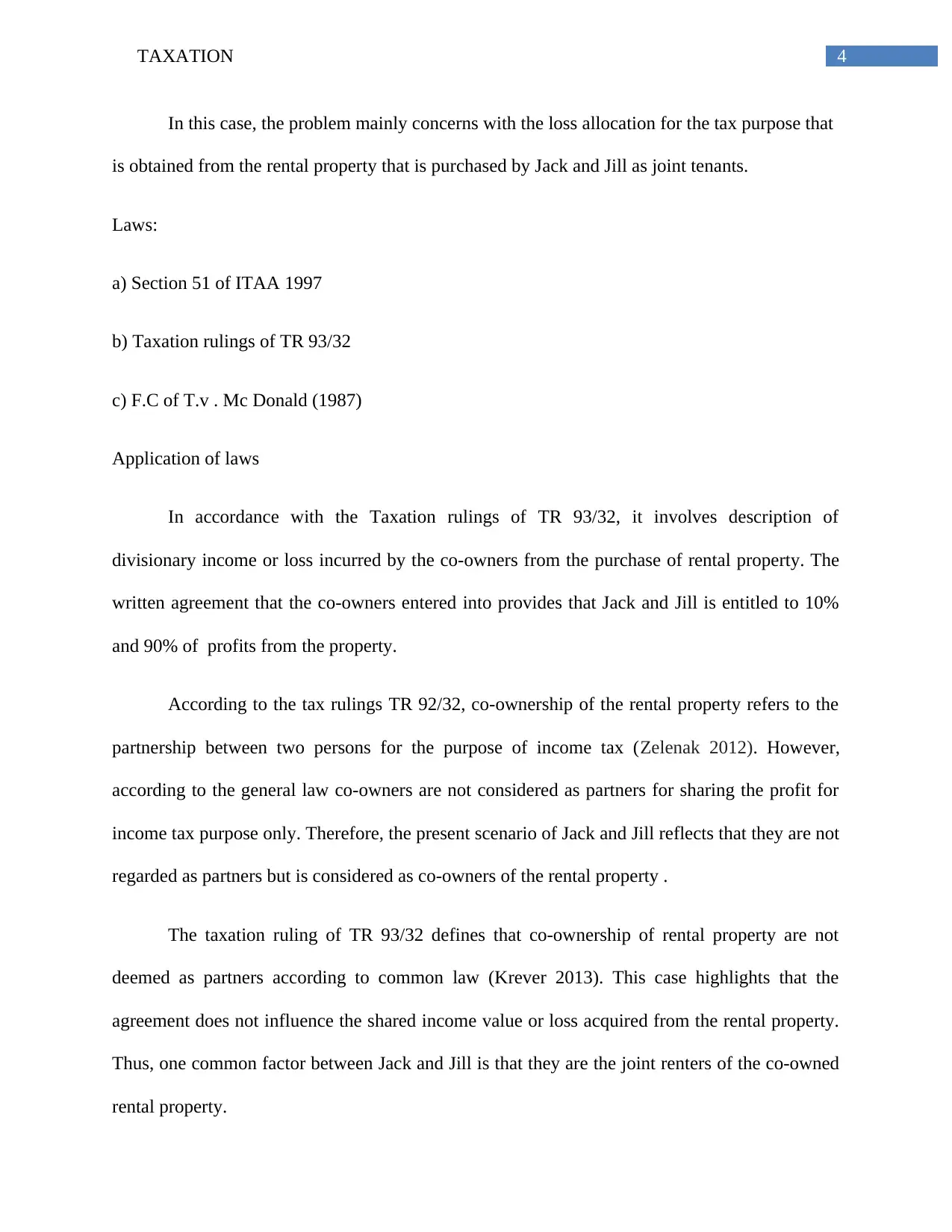
4TAXATION
In this case, the problem mainly concerns with the loss allocation for the tax purpose that
is obtained from the rental property that is purchased by Jack and Jill as joint tenants.
Laws:
a) Section 51 of ITAA 1997
b) Taxation rulings of TR 93/32
c) F.C of T.v . Mc Donald (1987)
Application of laws
In accordance with the Taxation rulings of TR 93/32, it involves description of
divisionary income or loss incurred by the co-owners from the purchase of rental property. The
written agreement that the co-owners entered into provides that Jack and Jill is entitled to 10%
and 90% of profits from the property.
According to the tax rulings TR 92/32, co-ownership of the rental property refers to the
partnership between two persons for the purpose of income tax (Zelenak 2012). However,
according to the general law co-owners are not considered as partners for sharing the profit for
income tax purpose only. Therefore, the present scenario of Jack and Jill reflects that they are not
regarded as partners but is considered as co-owners of the rental property .
The taxation ruling of TR 93/32 defines that co-ownership of rental property are not
deemed as partners according to common law (Krever 2013). This case highlights that the
agreement does not influence the shared income value or loss acquired from the rental property.
Thus, one common factor between Jack and Jill is that they are the joint renters of the co-owned
rental property.
In this case, the problem mainly concerns with the loss allocation for the tax purpose that
is obtained from the rental property that is purchased by Jack and Jill as joint tenants.
Laws:
a) Section 51 of ITAA 1997
b) Taxation rulings of TR 93/32
c) F.C of T.v . Mc Donald (1987)
Application of laws
In accordance with the Taxation rulings of TR 93/32, it involves description of
divisionary income or loss incurred by the co-owners from the purchase of rental property. The
written agreement that the co-owners entered into provides that Jack and Jill is entitled to 10%
and 90% of profits from the property.
According to the tax rulings TR 92/32, co-ownership of the rental property refers to the
partnership between two persons for the purpose of income tax (Zelenak 2012). However,
according to the general law co-owners are not considered as partners for sharing the profit for
income tax purpose only. Therefore, the present scenario of Jack and Jill reflects that they are not
regarded as partners but is considered as co-owners of the rental property .
The taxation ruling of TR 93/32 defines that co-ownership of rental property are not
deemed as partners according to common law (Krever 2013). This case highlights that the
agreement does not influence the shared income value or loss acquired from the rental property.
Thus, one common factor between Jack and Jill is that they are the joint renters of the co-owned
rental property.
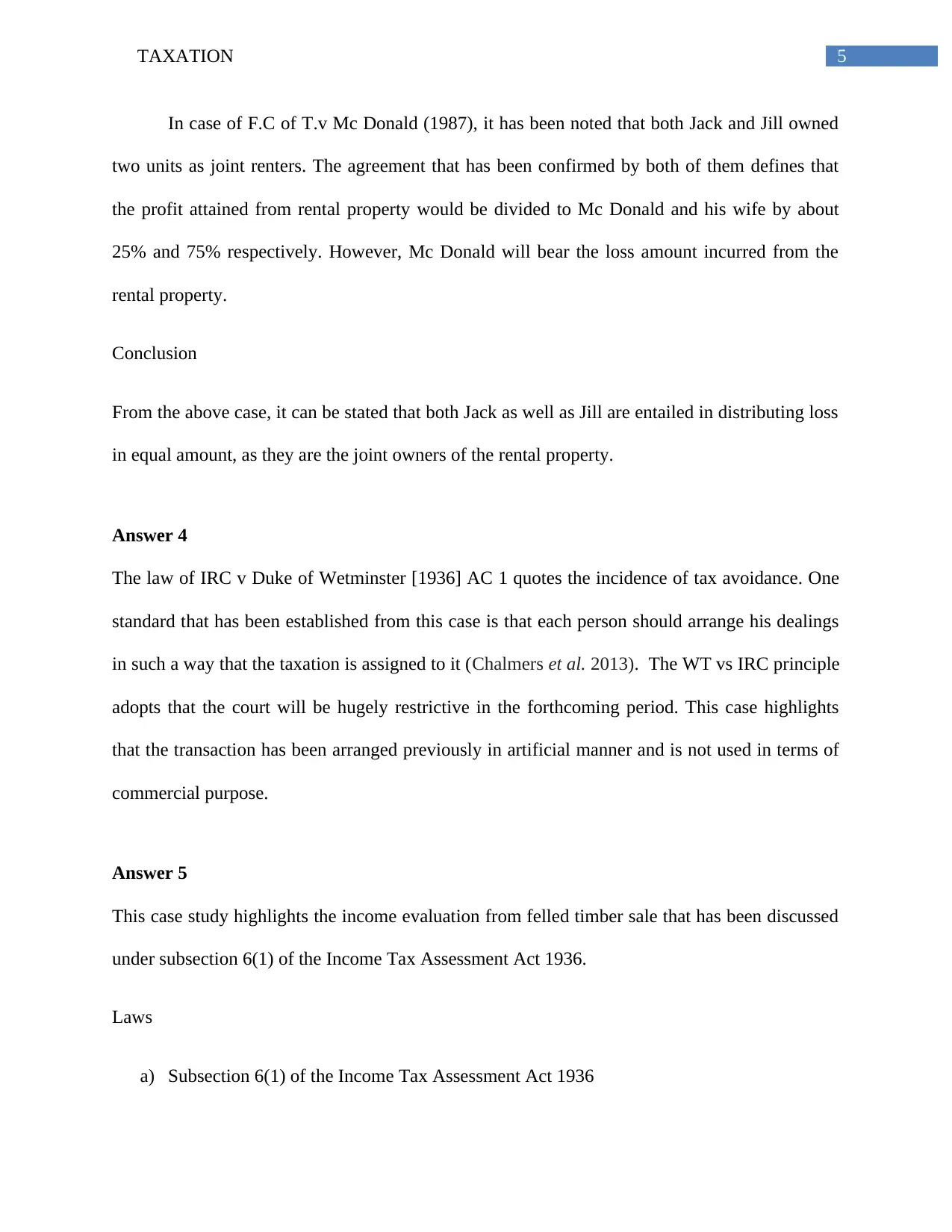
5TAXATION
In case of F.C of T.v Mc Donald (1987), it has been noted that both Jack and Jill owned
two units as joint renters. The agreement that has been confirmed by both of them defines that
the profit attained from rental property would be divided to Mc Donald and his wife by about
25% and 75% respectively. However, Mc Donald will bear the loss amount incurred from the
rental property.
Conclusion
From the above case, it can be stated that both Jack as well as Jill are entailed in distributing loss
in equal amount, as they are the joint owners of the rental property.
Answer 4
The law of IRC v Duke of Wetminster [1936] AC 1 quotes the incidence of tax avoidance. One
standard that has been established from this case is that each person should arrange his dealings
in such a way that the taxation is assigned to it (Chalmers et al. 2013). The WT vs IRC principle
adopts that the court will be hugely restrictive in the forthcoming period. This case highlights
that the transaction has been arranged previously in artificial manner and is not used in terms of
commercial purpose.
Answer 5
This case study highlights the income evaluation from felled timber sale that has been discussed
under subsection 6(1) of the Income Tax Assessment Act 1936.
Laws
a) Subsection 6(1) of the Income Tax Assessment Act 1936
In case of F.C of T.v Mc Donald (1987), it has been noted that both Jack and Jill owned
two units as joint renters. The agreement that has been confirmed by both of them defines that
the profit attained from rental property would be divided to Mc Donald and his wife by about
25% and 75% respectively. However, Mc Donald will bear the loss amount incurred from the
rental property.
Conclusion
From the above case, it can be stated that both Jack as well as Jill are entailed in distributing loss
in equal amount, as they are the joint owners of the rental property.
Answer 4
The law of IRC v Duke of Wetminster [1936] AC 1 quotes the incidence of tax avoidance. One
standard that has been established from this case is that each person should arrange his dealings
in such a way that the taxation is assigned to it (Chalmers et al. 2013). The WT vs IRC principle
adopts that the court will be hugely restrictive in the forthcoming period. This case highlights
that the transaction has been arranged previously in artificial manner and is not used in terms of
commercial purpose.
Answer 5
This case study highlights the income evaluation from felled timber sale that has been discussed
under subsection 6(1) of the Income Tax Assessment Act 1936.
Laws
a) Subsection 6(1) of the Income Tax Assessment Act 1936
⊘ This is a preview!⊘
Do you want full access?
Subscribe today to unlock all pages.

Trusted by 1+ million students worldwide
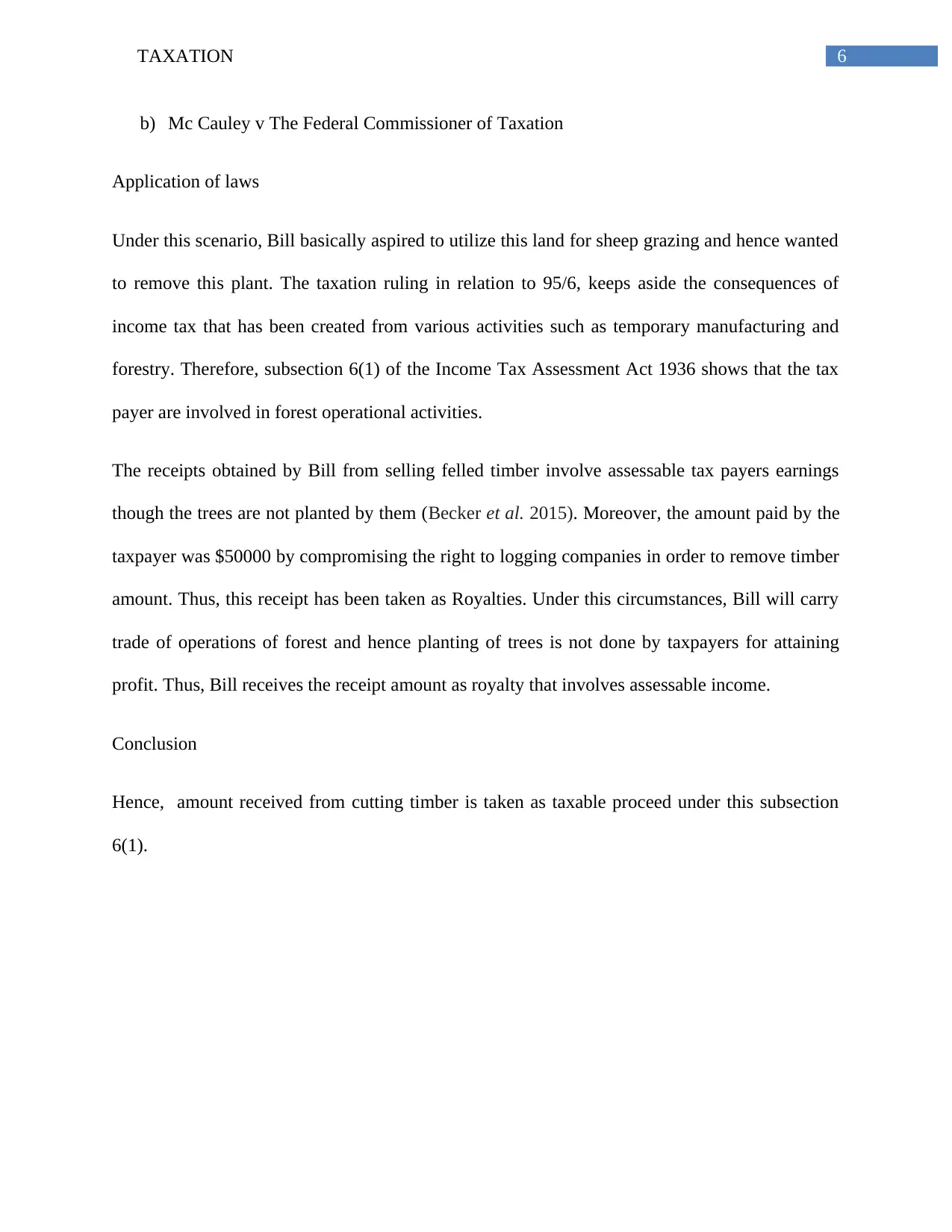
6TAXATION
b) Mc Cauley v The Federal Commissioner of Taxation
Application of laws
Under this scenario, Bill basically aspired to utilize this land for sheep grazing and hence wanted
to remove this plant. The taxation ruling in relation to 95/6, keeps aside the consequences of
income tax that has been created from various activities such as temporary manufacturing and
forestry. Therefore, subsection 6(1) of the Income Tax Assessment Act 1936 shows that the tax
payer are involved in forest operational activities.
The receipts obtained by Bill from selling felled timber involve assessable tax payers earnings
though the trees are not planted by them (Becker et al. 2015). Moreover, the amount paid by the
taxpayer was $50000 by compromising the right to logging companies in order to remove timber
amount. Thus, this receipt has been taken as Royalties. Under this circumstances, Bill will carry
trade of operations of forest and hence planting of trees is not done by taxpayers for attaining
profit. Thus, Bill receives the receipt amount as royalty that involves assessable income.
Conclusion
Hence, amount received from cutting timber is taken as taxable proceed under this subsection
6(1).
b) Mc Cauley v The Federal Commissioner of Taxation
Application of laws
Under this scenario, Bill basically aspired to utilize this land for sheep grazing and hence wanted
to remove this plant. The taxation ruling in relation to 95/6, keeps aside the consequences of
income tax that has been created from various activities such as temporary manufacturing and
forestry. Therefore, subsection 6(1) of the Income Tax Assessment Act 1936 shows that the tax
payer are involved in forest operational activities.
The receipts obtained by Bill from selling felled timber involve assessable tax payers earnings
though the trees are not planted by them (Becker et al. 2015). Moreover, the amount paid by the
taxpayer was $50000 by compromising the right to logging companies in order to remove timber
amount. Thus, this receipt has been taken as Royalties. Under this circumstances, Bill will carry
trade of operations of forest and hence planting of trees is not done by taxpayers for attaining
profit. Thus, Bill receives the receipt amount as royalty that involves assessable income.
Conclusion
Hence, amount received from cutting timber is taken as taxable proceed under this subsection
6(1).
Paraphrase This Document
Need a fresh take? Get an instant paraphrase of this document with our AI Paraphraser
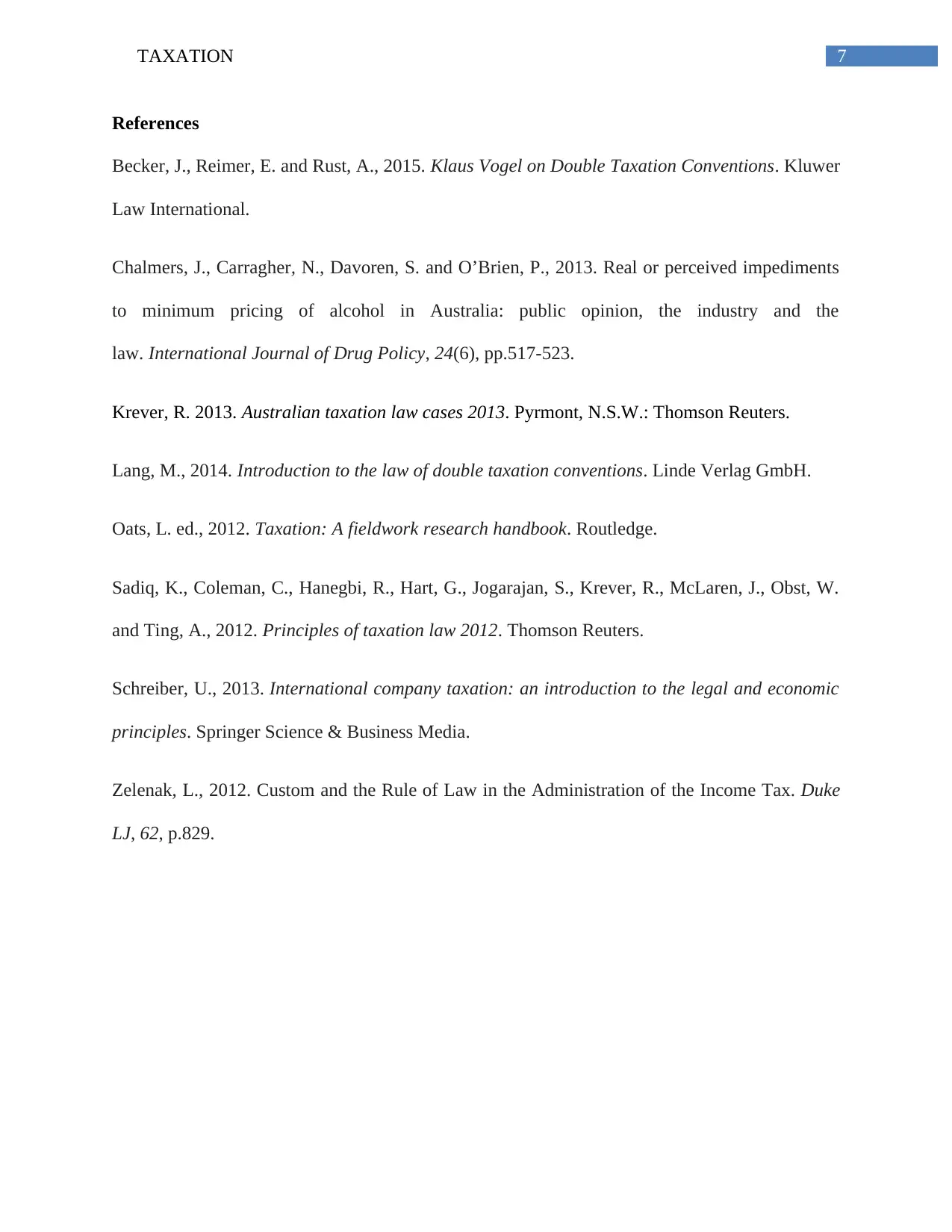
7TAXATION
References
Becker, J., Reimer, E. and Rust, A., 2015. Klaus Vogel on Double Taxation Conventions. Kluwer
Law International.
Chalmers, J., Carragher, N., Davoren, S. and O’Brien, P., 2013. Real or perceived impediments
to minimum pricing of alcohol in Australia: public opinion, the industry and the
law. International Journal of Drug Policy, 24(6), pp.517-523.
Krever, R. 2013. Australian taxation law cases 2013. Pyrmont, N.S.W.: Thomson Reuters.
Lang, M., 2014. Introduction to the law of double taxation conventions. Linde Verlag GmbH.
Oats, L. ed., 2012. Taxation: A fieldwork research handbook. Routledge.
Sadiq, K., Coleman, C., Hanegbi, R., Hart, G., Jogarajan, S., Krever, R., McLaren, J., Obst, W.
and Ting, A., 2012. Principles of taxation law 2012. Thomson Reuters.
Schreiber, U., 2013. International company taxation: an introduction to the legal and economic
principles. Springer Science & Business Media.
Zelenak, L., 2012. Custom and the Rule of Law in the Administration of the Income Tax. Duke
LJ, 62, p.829.
References
Becker, J., Reimer, E. and Rust, A., 2015. Klaus Vogel on Double Taxation Conventions. Kluwer
Law International.
Chalmers, J., Carragher, N., Davoren, S. and O’Brien, P., 2013. Real or perceived impediments
to minimum pricing of alcohol in Australia: public opinion, the industry and the
law. International Journal of Drug Policy, 24(6), pp.517-523.
Krever, R. 2013. Australian taxation law cases 2013. Pyrmont, N.S.W.: Thomson Reuters.
Lang, M., 2014. Introduction to the law of double taxation conventions. Linde Verlag GmbH.
Oats, L. ed., 2012. Taxation: A fieldwork research handbook. Routledge.
Sadiq, K., Coleman, C., Hanegbi, R., Hart, G., Jogarajan, S., Krever, R., McLaren, J., Obst, W.
and Ting, A., 2012. Principles of taxation law 2012. Thomson Reuters.
Schreiber, U., 2013. International company taxation: an introduction to the legal and economic
principles. Springer Science & Business Media.
Zelenak, L., 2012. Custom and the Rule of Law in the Administration of the Income Tax. Duke
LJ, 62, p.829.
1 out of 8
Related Documents
Your All-in-One AI-Powered Toolkit for Academic Success.
+13062052269
info@desklib.com
Available 24*7 on WhatsApp / Email
![[object Object]](/_next/static/media/star-bottom.7253800d.svg)
Unlock your academic potential
Copyright © 2020–2025 A2Z Services. All Rights Reserved. Developed and managed by ZUCOL.





